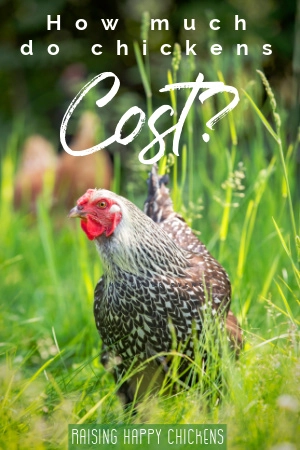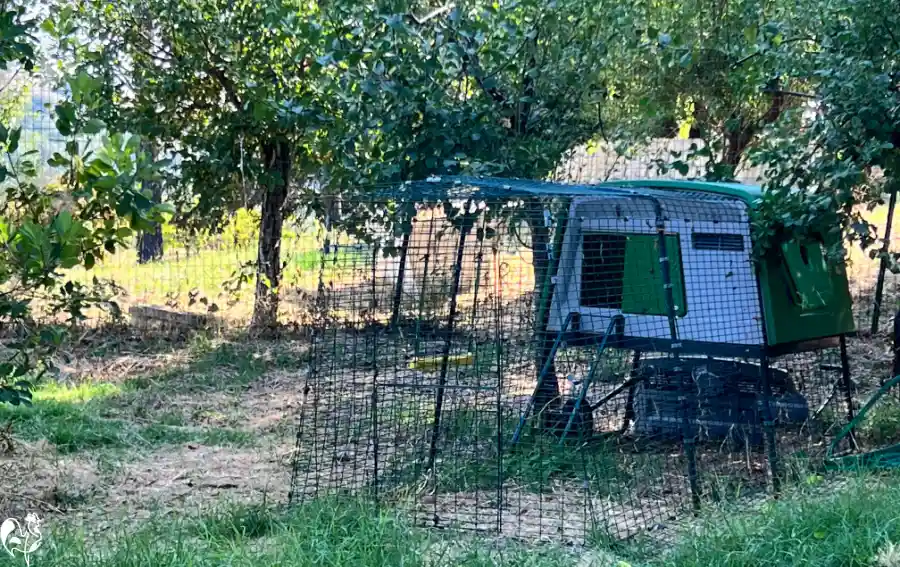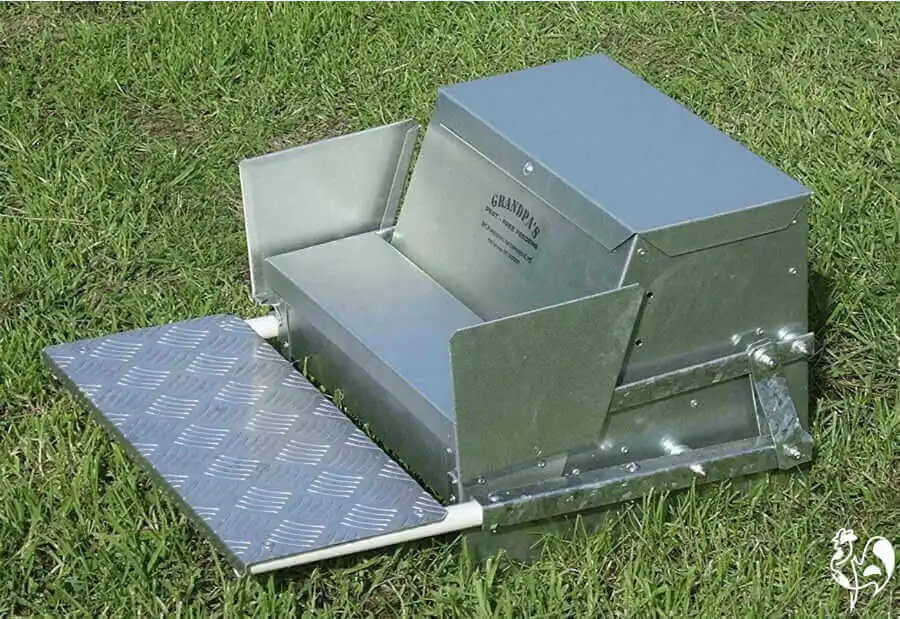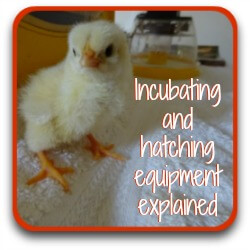- Home
- Beginner's Guide
- Costs
How much do chickens cost?
We all have the dream: a flock of contented, happy chickens wandering round our backyard, munching on all the garden pests we want to get rid of and clucking contentedly as they lay their large, nutritious eggs.
We may even think we can sell those eggs. That will surely cover the cost of keeping our feathered family.
Or will it?
Let's look at the reality of how much chickens cost.
In this article we'll look at different costs:
* The set-up cost of keeping chickens: basics you'll need which are generally one-time only.
* The ongoing costs of keeping chickens: everyday costs you'll need to budget for.
* Some sections are broken into two: high and low cost, and the pros and cons of each. If there's no specific difference, an average cost is given.
* All suggestions and costings are based on having four large breed chickens. If you plan on having more, simply multiply the costs.
* If you intend to have bantam chickens, you can happily reduce both the space, and the amount of food.
Want some help? No problem – have a worksheet!
* For my "Chicken Digest" newsletter family, this article is updated and sent twice a year. With it I include a free downloadable worksheet which is a cost calculator. It allows you to estimate the average cost of whichever set-up you decide is best for your individual circumstances.
* If you're not already a subscriber and you'd like to receive the free download, you can sign up here.
* If you are a subscriber and haven't had the checklist, reply to any of my emails and ask me!
Before you start...
Be aware that different places have different laws regarding keeping backyard chickens. Don't spend any money until you've checked what your area says.
Not sure how to do that?
Read my article about chickens and the law.
This is a very long and detailed article.
Use these links to jump to a section you're particularly interested in, or carry on scrolling for the whole story.
How much do chickens cost? Setting up to welcome them.
Generally speaking, chickens are pretty self-sufficient. Give them a secure home, a supply of food and water, a shelter from extremes of weather and somewhere to scratch about and they'll be happy.
But those things do take money. So we'll start by looking at the (mostly) one-off costs of having chickens of any age – items you should only need to buy once, unless you decide to replace them later.
When you're working out how much chickens cost, remember...
You'll hopefully have chickens for years. Buy items which are likely to last longest, at a price you can afford.
If you purchase a product through links on this page, I may receive a small commission at no extra cost to you. I only recommend products I have bought (or would buy) myself, and which I believe will genuinely benefit you. You can read my full disclosure policy here.
What is the cost of a chicken house?
This is probably the most expensive item you'll ever buy for your chickens, and there's certainly a wide choice between the cost of chicken houses (also called "coops").
So it's absolutely essential that you take time to choose the right one for your situation.
Whichever you finally decide on, the important thing is to know the features you're looking for, which are basically:
- space: to meet basic welfare needs, each chicken should have around 4 square feet (or one third of a square metre) of space, if they are going to spend a lot of time in their coop. If they are basically in their coop only to sleep, the more important measurement is the roosting bars.
- roosting bars: enough space for between 10" and 12" (or 25cm to 35cm) per chicken. Find more detailed information about roosting bars here.
- predator proof: made of materials which predators in your area can't easily break through, and door latches and locks which can't be easily opened!
- well ventilated: it's critical to have ventilation above the level of your chickens' heads, to avoid a build-up of moisture and nitrogen fumes from droppings.
- nest box area: at least one for every two chickens (see this section).
- easy to clean: you may not think this is important when you're just starting out but trust me – you will!
Is there any such thing as a low cost, cheap chicken coop?
If you're looking for a low cost, simple chicken house for about four large breed chickens, you're likely to find wooden coops to be the least expensive.
I've had one of these, so I'm well placed to comment.
Looking at the photo below, make special note of the lock on the door. A raccoon would have that open in no time!
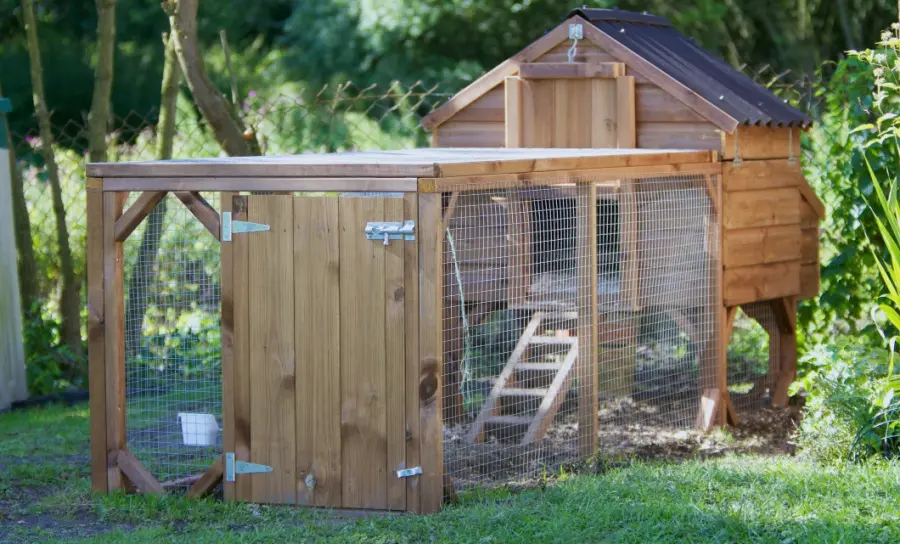
Pros of wooden coops.
- Generally inexpensive
- Good as first coops if you're just starting out and you're prepared to upgrade eventually
- Most have a small integrated run underneath
- Usually fairly light to move around.
Cons of low cost wooden chicken coops.
- Wooden coops tend to harbour red chicken mites, which are difficult to control.
- Wood tends to deteriorate fairly quickly over time – mine lasted about two years before it needed replacing.
- Locks on cheap coops tend to be flimsy and easily pulled off or opened – you'll need to upgrade them.
- Check the wire on the run: if it's ordinary chicken wire don't buy it. It's too easily pulled apart by predators. You need a strong, good quality mesh, with an 'L' skirt added on the ground to deter digging mammals.
- The run area tends to be very small, inadequate for more than two chickens and will need moving to allow the ground they cover to regenerate. I place my wooden coop (below) inside a large run so the chickens have more space to forage.

- They also have more protection in this setup, since the large run within which the wooden coop is set has a six foot, chain-linked fence.
How much do wooden chicken coops cost?
A small wooden coop can cost as little as $99.
But beware: you get what you pay for, and a cheap coop is likely to be made of very poor quality materials which will very quickly fall apart. So getting a cheap coop may be a false economy.
Check out the price on Amazon of a mid-range wooden chicken coop using the button below.
A more expensive option: the plastic chicken coop.
I know – plastic sounds like the last thing you want your chickens to live in. But it depends on the type of plastic, and on the design.
I have two "plastic" chicken coops – Omlet's Eglu Cube – and I wouldn't have anything else.
Pros of the Omlet Eglu chicken coop.
- The Cube is large enough for between four and six large breed chickens.
- No place for mite to hide – a major bonus!
- Built in ventilation ensures no build up of dangerous moisture or nitrogen fumes and double wall insulation ensures a cool coop in summer, warm in winter.
- Separate nest box area with an external door for collection.
- Predator proof: I have foxes, chickens and wolves near my home in Italy and none has been able to get into my Eglu Cube and run. The 'L' shaped "skirt" at the bottom of the run prevents digging predators and is held down by Omlet's special screws which are impossible for even raccoons to pull out!
- Easily cleaned – back door comes off and roosting bars with droppings board slide out.
- Can be set up with wheels to make a movable "chicken tractor".
- "Add-ons" are available: larger run, automatic door opener, coop covers to protect from extreme cold, run covers for shade from sun or rain, perches, chicken swings – the possibilities are endless!
Any negatives of Omlet's Eglu Cube?
- It takes a while to assemble. Watching Omlet's own videos make it much easier.
- It's not cheap.
- On the other hand, I have had my first Eglu for over ten years now and it's still in perfect condition.
- So the cost has to be balanced against the fact that my wooden coop was unusable within two years.
How much will you spend on your chicken coop?
Use your downloadable list to make a note of the running cost.
How much do chickens cost? Nest boxes.
I have a very specific piece of advice about nest boxes.
Don't spend much (if any) money on them!
Why not? Two reasons.
Firstly, You'll soon discover that all your hens will want the same one.
Secondly, you'll discover that they'll lay where they want to, not in your lovely designer nest boxes.
I spent a lot of money buying some very good (and expensive) nest boxes. As you can see, my chickens totally ignored them in favour of some hay bales.
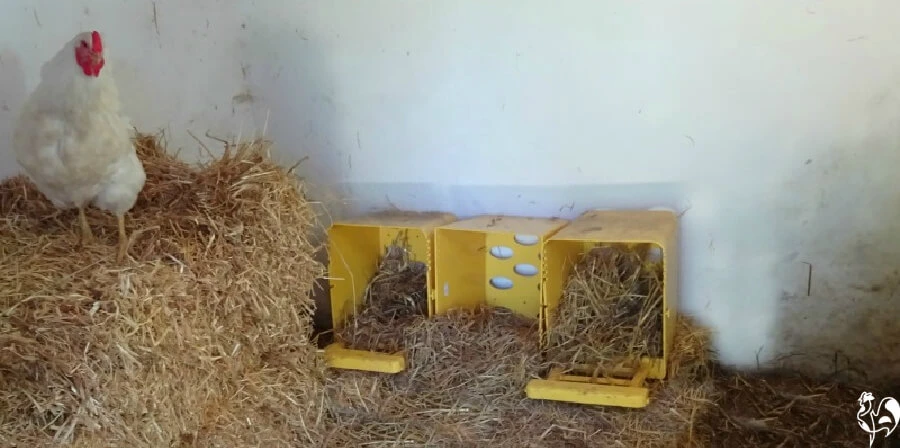
Of course, if you have a coop like the Eglu Cube, the nest box is already provided.
If not, take a look at my article about different things that can be used as nest boxes before making any decision.
The article includes videos with step-by-step instructions for making simple, inexpensive DIY nest boxes.
How much will you spend on nest boxes?
Use your downloadable list to make a note of the running cost.
A low cost, DIY chicken run: is there such a thing?
As well as their coop, where they will basically go to sleep, your chickens need somewhere to wander, rummage, forage and play.
The chicken run.
Here are the main features you're looking for...
- Security from predators: the most important concern. Find out which predators you have, and buy accordingly.
- Size: in effect the bigger, the better. If your flock is confined to a run (that is without free-ranging time), each large breed chicken should have at least one square metre (about 11 square feet) of ground – preferably more.
- Water and feed areas: enough space for your feeder and a waterer. In a large run, several watering stations which can be as simple as a (regularly cleaned) bucket or regular waterer.
- Shaded areas: from extremes of weather. This might be trees, or simply easy access to their coop.
There will be other features of a run, but they can be added in the future. As long as your run is predator proof and large enough to allow chickens the space they need, you're good to go.
Can it be done yourself? I couldn't, but if you happen to have a "handy" person to help, maybe!
Adding a large, secure mesh run: the expensive option.
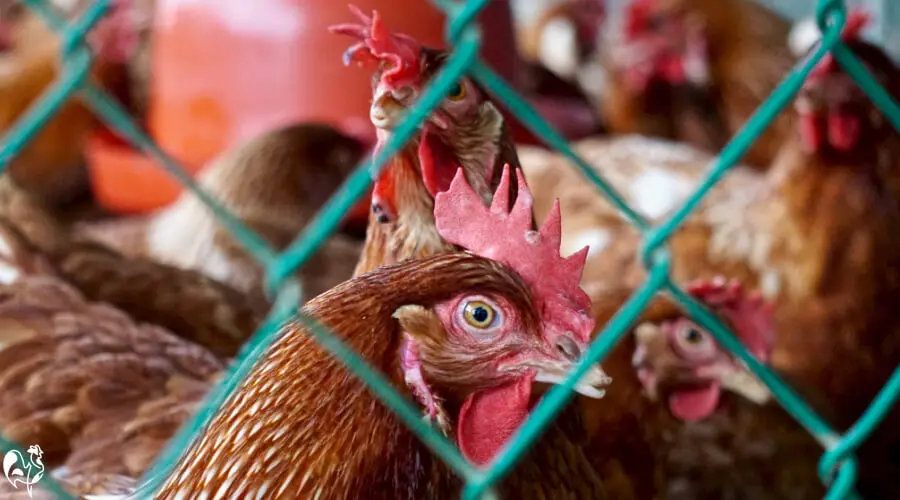
This is what I have as my Italian chicken run. It's made of plastic coated galvanised metal, is 6 feet high and buried 18" underground, with an 'L' shaped apron above ground.
It was extremely expensive, but worked in keeping predators out.
How much do chickens cost? Introducing Omlet runs: the less expensive option.
If you have a smaller area for your chickens, my recommendation would be to look at Omlet's runs.
From small runs which connect to one of the Eglu coops to large, walk-in runs, these are the ultimate in predator-proof, chicken- and people-friendly places for your flock to chill out.
They're not cheap, but much less expensive than having a chain-link boundary fence! The greatest bonus is that you can choose the exact size to fit your space – and extend it when you get more chickens!
Choosing a run doesn't have to be a once-and-for-all thing. If you start with two or three chickens and a small-ish run, you'll be able to expand as your flock grows.
Once you've researched runs, add an approximate price to your costs. You can always change it later.
How much will you spend on your chicken run?
Use your downloadable list to make a note of the running cost.
Chicken feeder and waterer ideas.
These items are among the most important you'll invest money in.
Why?
Not only because they're vital for your chickens' health, not only because having the right ones means you will have less work to do, but also and critically because using the wrong ones can lead to problems – including rodents.
What features should you look for in feeders and waterers?
- Size: this is more to do with how often you want to be filling them, rather than how many chickens you have. I tend to go for larger so that, if I want to go away for a few days, I know my chickens won't need much looking after.
- Rodent-proof: the most important feature. Chickens do not attract rodents – grain does. And wild birds – who can spread bird flu – will happily eat your chicken feed if allowed. So your feeders particularly need to keep them out whilst still allowing your chickens free access. In particular, make sure that both food and water are raised off the ground.
- Weather resistant: chickens don't eat or drink at night, so food and water should not be left in your coop unless your chickens are inside all the time. Because these containers are left outside, look for a durable material which won't rot or leech chemicals into the food and water.
- Stable: don't lose food, or create a massive waterer-pool, by having containers that are likely to topple over if a few boisterous chickens pass by!
- Easy to fill: look for a large hopper-type style for a feeder, and a waterer with a top opening you can fit a hose into.
- Easy to clean: essential to make sure you don't get build-up of mould in feed or algae and bacteria in water.
So which is the best chicken feeder?
It's easy to buy a very inexpensive plastic feeder online or at your local feed store. When I had no real experience, I used this type. The hopper allows feed to flow into the saucer at the bottom as the chickens eat.
The problem? It provided an excellent free take-out for rats and wild birds.
Even hanging it didn't solve the problem – rats can jump!
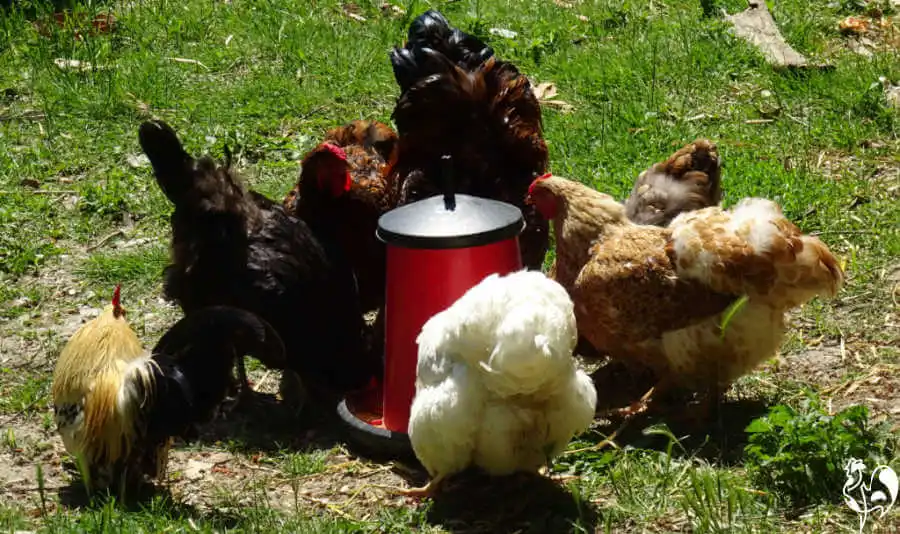 My chickens loved it – and so did the rats!
My chickens loved it – and so did the rats!But they're inexpensive, and therefore tempting when you're starting out.
If you use a feeder like this, make sure you lock the grain away somewhere secure at night.
My best chicken feeder recommendation.
- Having tried different feeders over many years, there is only one answer for me: Grandpa's Automatic chicken treadle feeder. I have had mine for years and highly recommend it.
- It works by the chickens (yes, even bantams!) standing on the treadle, which raises the feeder lid. As soon as the chicken hops off, the lid closes and is secure.
Any drawbacks of Grandpa's automatic chicken feeder?
- Like most items which will last for years, it's expensive – at first sight.
- But mine has (so far) lasted for twelve years and is still going strong. So divide the cost by – let's say – ten years, add in the amount of grain you'll save, and you'll find Grandpa's is actually very reasonable.
- There are two sizes available. My advice would be that if there's any chance of you growing your flock, buy the larger one. the price difference is not huge and you'll be future-proofing your set-up.
How much will you spend on a chicken feeder?
Use your downloadable list to make a note of the running cost.
How much do chickens cost – what about the best chicken waterer?
Again, there are a lot of different possibilities for waterers, both plastic and metal. We'll keep it simple by looking at one of each.
- Plastic waterers have the advantage of being less expensive.
- They're also able to combine fresh water with apple cider vinegar, should your chickens need it. Metal containers can't.
- They tend to be smaller than metal waterers, which means filling them more regularly but also means there is less likelihood of them harbouring bacteria.
- These types of feeder are light enough to be hung, for example from a tree, so that rodents can't access them and chickens, who rely on gravity to swallow liquid, don't have to bend their heads to drink.
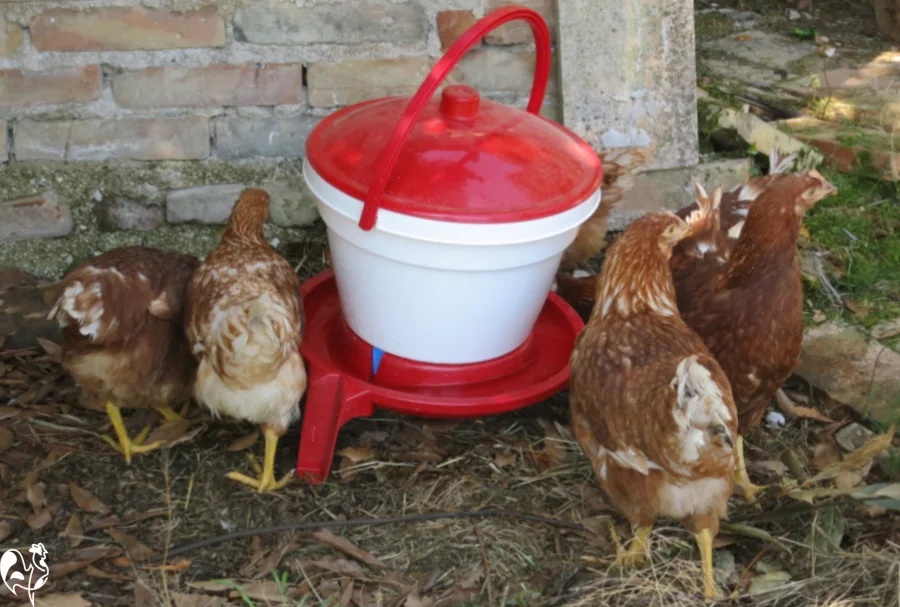 Plastic waterers can be hung and are a good solution for a small flock.
Plastic waterers can be hung and are a good solution for a small flock.The metal chicken waterer.
I love this waterer, which I bought at my local feed store. I haven't been able to find a similar one online.
Its advantages are...
- It's a 5 gallon waterer, so lasts a large flock for several days.
- It releases water from the drum into a large saucer partway up but underneath the legs, keeping the liquid away from both rodents and wild birds.
- The legs and the weight of the water keep this waterer very stable, even when used by a larger flock.
- It keeps water fresh, as long as it's kept in the shade.
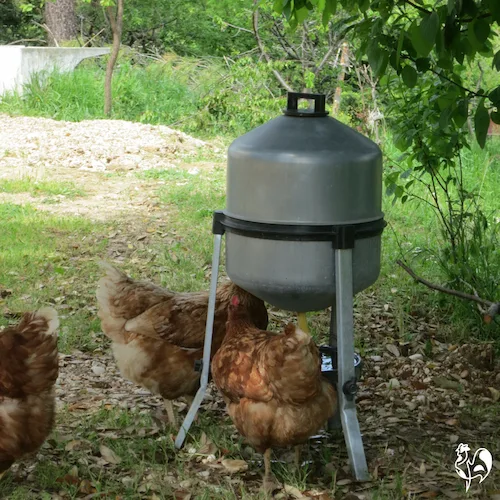
- To achieve a similar effect, find a metal container and hang it, or use bricks to raise it from the ground.
- The massive benefit of a metal waterer without legs is that it can be used in winter with a heater base, to keep water from freezing.
How much will you spend on chicken waterers?
Use your downloadable list to make a note of the running cost.
What's the cost of a live chicken?
You now have the infrastructure set up to home your happy chickens!
But how much do chickens cost?
Chickens can cost virtually nothing, or several hundred dollars – it all depends what you want.
- Do you want to show your chickens? Birds specially raised to show standards from a licensed breeder can cost many hundreds of dollars.
- Do you want to rescue your chickens? Rescue centres or charities like the British Hen Welfare Trust or Chicken Run Rescue in the US will re-home ex-battery caged chickens at little or no cost to you – perhaps a donation.
- Do you want to choose your own breeds, but not to show standard? Try a hatchery such as Cackle (which I recommend). Even if you're not based in the USA, their choices will give you a good indication of price.
How much will you spend on your chickens themselves?
Use your downloadable list to make a note of the running cost.
How much do chickens cost in the longer term?
You've now worked out the costs to set up the basics to receive your chickens. Make sure to fill in the first section of the downloadable list, and then...
- Assess whether you can afford the set-up you aspire to.
- If not, can you accept that you need to aim lower initially, knowing that eventually you may be able to have the coop and other elements of your dreams? That is exactly what I did.
- Work on the financial calculations until you feel you've reached your optimum budget with a set-up you can, at least, live with.
But that's not all. There are ongoing costs which you need to factor in before you can have a realistic view of a monthly budget.
So let's look at those additional ongoing costs and factor in one month's supply for each.
Chicken coop bedding.
Depending on the size and design of your coop, your chickens are going to need bedding in their coop, their nest boxes and potentially (if it's muddy, for example) their run.
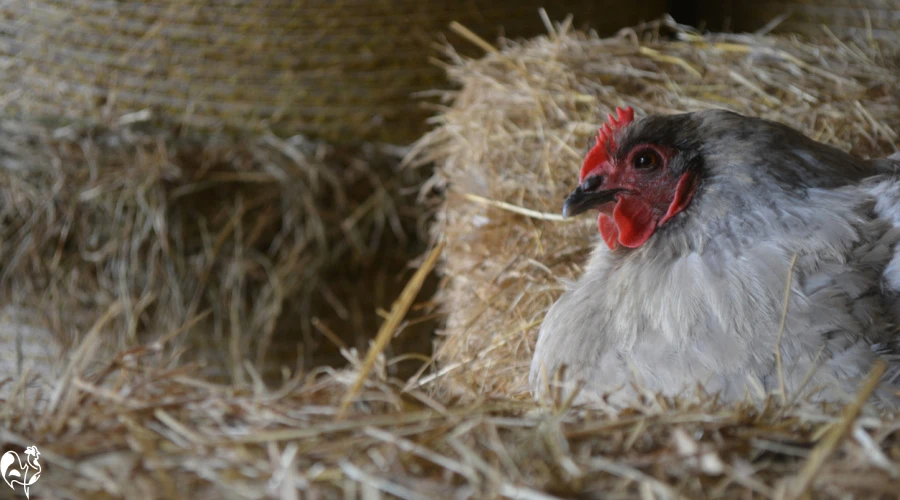
You will need to factor in how often you change the bedding in your coop. It should be cleaned of poop every day, and changed completely once a month – more frequently if it starts to smell.
- Straw: not ideal, since it's not as absorbent as and can harbour bacteria, mould and mites. However, it's ideal for nest boxes since it cushions the eggs, and it's inexpensive – you may even be able to get some for free if a local farmer has straw to spare. When it needs clearing out, add to your compost pile for some free soil and plant booster!
- Pine shavings: inexpensive and more absorbent than straw, so a popular bedding. But they don't compost down well so not terribly eco-friendly. Make sure you buy untreated pine shavings – not chemically treated.
- Hemp bedding: much more absorbent than straw, hemp can hold up to four times its own weight in liquid. It also masks odours so your coop is less likely to have a build-up of the nitrogen which comes with an excess of chicken poop. It's relatively expensive though, so I wouldn't use it if you have a large barn, for example, as your coop.
- Would hemp bedding work in your coop?
Bedding in the nest boxes.
- Straw is popular (and inexpensive) in nest boxes. Chickens don't use their nest boxes as toilets, so there's no problem about absorbency, and straw is soft enough for hens to feel at home when laying!
- Nest box liners: I've found these to be both easy to use and effective. More expensive than straw, you can also buy them readily infused with herbs to help your hens relax as they lay!
Calculate your need for bedding in the coop and nest boxes. Allow for a good 2 - 3 inches of bedding in the coop, and a layer of straw or a nest pad in the laying area which should last for several weeks.
How much will you spend on bedding per month?
Use your downloadable list to make a note of the running cost.
How much do chickens cost to feed?
Chickens need a different type of feed depending on their age, but the amount of food they need is fairly consistent, whatever their life stage.
They can supplement commercial feed by foraging for bugs and with treats, for example, but their main diet should always be a good quality feed properly balanced for the nutritional benefits they need at different growth stages.
So budget for their feed at this point. You can always add in treats later (and many of them can be grown either inexpensively or at no cost at all).
A chicken feed cost calculator.
- As a general "rule of thumb", allow about 2lb of feed per chicken per week.
- So if you plan to have 4 chickens, you would need 8 lbs of food per week, or 32 lbs per month.
- You're likely to save money by buying the largest amount you can afford – provided you have a moisture free, rodent proof place to keep it.
How much will you spend per month on chicken feed?
Use your downloadable list to make a note of the running cost.
Chickens and oyster shell.
It's ultra-important that your laying hens have access to a form of calcium. If they don't you'll have issues with soft-shelled eggs and hens with brittle bones.
The most common – and effective – means of ensuring they have enough calcium is by free feeding oyster shell. Hens will take as much as they need; males don't need it at all and will leave it alone.
Oyster shell, or a substitute, is not very expensive. You will need a bag every couple of months.
How much will you spend per month on oyster shell?
Use your downloadable list to make a note of the running cost.
How much do veterinary bills cost?
This is a hard one to calculate.
- Not all veterinarians will treat poultry, so your first step is to check whether yours does.
- If they don't, you may be able to find someone locally who has their own flock and is well versed in chicken health.
- If neither of those works, it's time for you to learn about chicken health yourself!
- You'll have a lot of help from others including websites like this one, and organisations who celebrate chickens such as the British Hen Welfare Trust, who have a Hen Helpline.
- Members of my Chicken Digest family also receive a free downloadable checklist of items to keep in a Chicken First Aid box. Items on this list would be the minimum expenditure you need to make to keep your chickens safe and healthy.
How much will you spend on veterinary bills or first aid items?
Use your downloadable list to make a note of the running cost.
How much do chickens cost? Summary.
You now have enough information to make an informed decision about whether the cost of chickens is within your budget, or whether you need to look again at your expectations.
What you need not to do is to think that chickens can pay for themselves.
- You may be able to sell eggs – but there are regulations to be taken account of.
- You may be able to sell chicks, or even fertisilised eggs – eventually.
But for now, make an assumption that you will be spending money, but not making any.
What you will have, though, are many happy hours entertainment, and a constant supply of delicious, nutritious eggs!
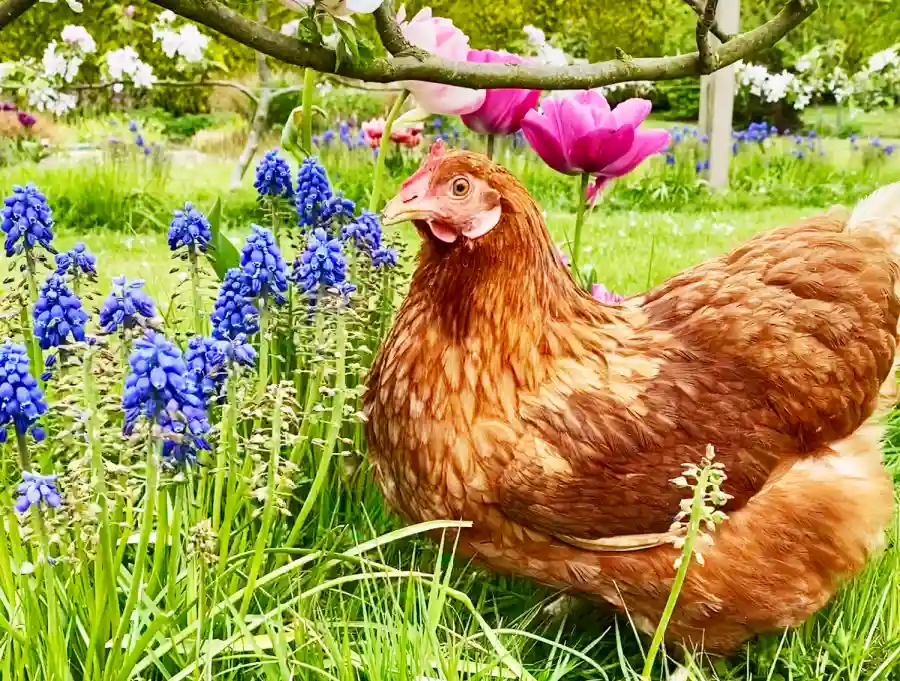 It will all be worth it in the end!
It will all be worth it in the end!Other articles you may find helpful.
- Home
- Beginner's Guide
- Costs
